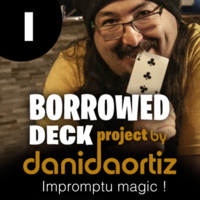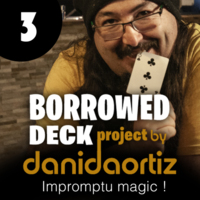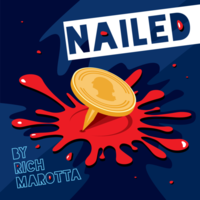Layers by Mike Pisciotta (Instant Download)
Take the classic 3 prediction trick to the next level. A pro-caliber version you'll be proud to perform at your next gig. START LEARNING INSTANTLY.
| Price: | $4.95 |
If you've been doing magic for even a year or two, you're probably familiar with the one-ahead triple prediction. Two-time "Close-up Magician of the Year" winner Mike Pisciotta has taken that concept to another level, making it a trick that fools everyone, and strong enough to do professionally.
You ask 3 questions, you make 3 predictions, they're all right. That's the basic idea.
But here's the biggest difference, for those of you who know the original: When you're making the 3 predictions, you write the number of the question on the paper that you're writing the prediction, so there's no question of when you wrote it. It really solidifies in the spectators' minds that you're doing what you say. It changes the whole routine.
You can apply the method to ANY triple prediction you want to do, or already do. The choreography and method are extremely versatile. For further ideas, applications, and information on this amazing principle please consult the work of Richard Osterlind as published in his book Mystique, and Jim Steinmeyer's Still Nothing But Mystery.
If you're looking for a rock solid trick to do when you don't have anything with you, check this out.
ASK HERE
Featured Magic Tricks
4 star 35%
3 star 14%
2 star 4%
1 star 4%

 Hello. I’m Debbie Downer...
Report this review
Hello. I’m Debbie Downer...
Report this review
Hello. I’m Debbie Downer.
It seems like everyone loves this trick when I read these reviews. To be honest though, I’m really scratching my head as to why. First off though, let me say that Mike is a likable guy and I really wanted to like the trick. In fact, I do feel bad for giving this buzzkill of a review. But reviews are supposed to be honest and, when I want to buy a product, I always look for the one negative review just so I can feel like I have a shot at getting the whole picture as to whether or not a product is a good one.
Let’s start with the positive, as I do not have any axes to grind. This truly is an anyone, anywhere trick. There are no gimmicks or difficult sleights. The only move required is one that any magician should know. It’s an easy trick and I will also say that this trick has a lot of potential. If you are beginning mentalist, this trick uses a basic principle that you will likely know but if you don’t, you’ll need to learn it. Another positive is that Mike does not stuff the explanation full of filler. He teaches the trick and then he’s done. Simple as that.
That said, here are the negatives. To me, the presentation is very lackluster. It’s boring (sorry Mike... just my personal opinion. No offense). There is only the one performance and even the spectators’ reactions are like “um ok. Neat.” I really would have like to have seen at least two more presentations that demonstrated his recommended handling for when different negative scenarios played out. Also, when I watched the presentation, I felt a little bad for him because I felt a sense of struggling or reaching in trying to read the spectator. There seemed to be no fluidity between the three guesses he was trying to make. This doesn’t feel magical or impressive to me. I think it’s because of the way he asked the questions and then revealed the answers. I don’t know how to put it... there were no surprises or ah-ha moments. The trick is there. But it doesn’t ever say “Ta-daaaaa!”
I guess that’s my major beef: the presentation needs work. It doesn’t flow. I think with a little creativity, rework, and showmanship though, there is potential. As it is, I personally will not use this presentation. The principle behind it, yes. The presentation, no.
If you are a beginning mentalist, go ahead and get this trick for the principle (though honestly there are better teachings of it. Luke Jermey does a really good job teaching this principle). It’s certainly affordable.
If you’re experienced at all, I can’t recommend this unless you’re just curious. Again the price point is low enough that you can say “oh what the heck” and get it. But it is a gamble. (Well, everyone else gave this trick great ratings... so maybe I’m the only one. Oh well just trying to be very honest.)
I was leaning toward giving this 2 stars. But based on the fact that a beginning mentalist should learn this principle and perhaps they would really benefit from this video more than I did, I’ll give it an extra star. 3 stars from me from this trick. Sorry, I feel like Debbie Downer:.. but Mike, I do hope that you will come out with another trick soon. I feel like this was just a poor start but that you as a magician have many tricks up your sleeve to share that will blow me away. I’d love to see one of those.
By the way, I always try to be honest and straightforward in my reviews, while being respectful to the magician. If you appreciate my reviews, can you please click the "Yes" button below beside the question, "Did this review help you?" It's not like I actually benefit in any way by your clicking it... but it would be nice to see if my reviews are helpful or not. I hope they are. If you ever have suggestions or comments or questions about my reviews, please feel free to leave me a constructive comment. I'm just trying to be helpful. I love the Penguin community and hope that I can someday contribute my own product. :-) Thanks for reading and for any (hopefully positive, but either way, at least kind) feedback.

 Could have been so much more.
Report this review
Could have been so much more.
Report this review
The best thing about this video? The added subtleties that take this principle to a different level than typical. Namely, the way you number the slips of paper as you go along. To me, this is the selling point of the effect, and I think Mr. Pisciotta should have played this up a bit more in his teaching. Performers could benefit from a further discussion of the psychological misdirection going on in the spectator's eye. Why does numbering the slips of paper matter in the first place? This is not discussed.
I also have to take issue with the ad copy: "You ask three questions, you make three predictions, they're all right."
It could work out that way. Maybe.
One of these three predictions (the last one, the shape) is an honest-to-goodness guess that might miss. In fact, I suspect you are more likely to miss than to hit. Mr. Pisciotta explains how this can easily be dismissed because the two hits will be so strong. I'm not sure I agree; wouldn't you want to hit three out of three times? Couldn't that third prediction be a force of some kind? I think Mr. Pisciotta intends a force by naming two shapes and assuming the spectator will pick a common third shape. But if so, this isn't explored or even mentioned in the video.
Furthermore, assuming a miss is likely, how can a miss be turned into a positive? In mind-reading, there are simply going to be times when you miss; it's a fact we live with. The experienced performer can gloss over a miss or twist it around to sound like a hit.
At best, Mr. Pisciotta's handling turns a miss into an "almost-hit", saying — in effect — "I wrote this because I misread your mind." I don't have a problem with that, but there are other alternatives for handling a miss. It would have been nice to have more discussion about this. For instance, if your performance style lends itself to humor, perhaps there's a punch-line you can use. (Maybe you can think of a punch-line appropriate for a a circle or a square or a triangle...)
This is a solid enough routine for beginners, but I think it could have been so much more with a little more thought.

 Very nice impromptu effect
Report this review
Very nice impromptu effect
Report this review
The camera angle on the video might lead you to think he's writing the answer after its given. But in the explanation you see that he's writing the numbers 1,2,3.
For the price, its a nice thing to have on hand for an impromptu effect.

 Great Version
Report this review
Great Version
Report this review

 Layers
Report this review
Layers
Report this review
Although as stated an old principal, you get an excellent real world performance and natural reactions.
Can be done on the fly , and there is a slight difference in the handling that I was not aware of that makes a huge difference and is the way I would perform this .

 Worth more than the asking price.
Report this review
Worth more than the asking price.
Report this review
One that 99% of pros will already be familiar with.
The handling has been updated, and I really like it.
While I am not a fan of Mike's patter, the method is outstanding. I will definitely be using it with my own patter.
This really is an excellent trick, and the method is sound.
The only reason I'm giving 4 stars, as opposed to 5, is because I feel Mike should have slowed down in the teaching of this one. It felt a bit rushed. I would have enjoyed hearing him elaborate a bit. I also wouldn't mind more than one real world example.
I really feel like this one can be enjoyed by beginners and pros alike.
Also, Halloween is coming up. Just change the patter and this can also become a spooky opening routine!

 Layers of Lameness
Report this review
Layers of Lameness
Report this review

 Devious and beautiful in construction.
Report this review
Devious and beautiful in construction.
Report this review
Like he says in the video, this won’t replace the envelope test in my stand up set. But this definitely takes place in my anytime anywhere mentalism next to Luke Jermay’s Emotional Intelligince.
Love it, I’ll use it. Mike’s teaching is superb.

 Gold Stuff!
Report this review
Gold Stuff!
Report this review

 Meh!
Report this review
Meh!
Report this review

Act Builder beta

















































